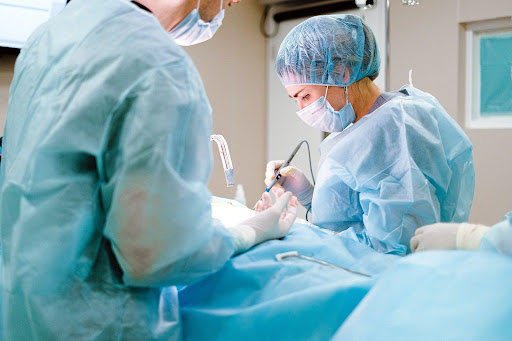Operating Hours:
Mon - Thu: 8:00AM – 4:30PM / Fri: 7:30AM - 4:00PM
Operating Hours:
Mon - Thu: 8:00AM – 4:30PM / Fri: 7:30AM - 4:00PM

In the constantly evolving domain of gynecology in Atlanta, procedures such as NovaSure and MyoSure have garnered attention. These advanced treatments address unique challenges women face, and their comparative significance is paramount for informed medical decisions. Here, we dive deep into NovaSure vs MyoSure to shed light on their nuances and applications.
NovaSure represents a transformative step in the field of gynecological treatments. Specifically, it addresses the problem of excessive menstrual bleeding, otherwise known as menorrhagia. For many women, this condition can be a severe impediment, affecting their quality of life, emotional well-being, and daily activities. In the context of NovaSure vs MyoSure, it’s crucial to understand how each technique is designed to tackle distinct women’s health challenges.
NovaSure adopts a minimally invasive technique. The procedure entails the insertion of a slim wand into the uterus. This wand then disperses radiofrequency energy that eradicates the endometrial lining that’s causing heavy menstruation.
What stands out about NovaSure is its efficiency; the process typically concludes in under five minutes. It presents a sustainable solution for those battling with intense bleeding without leaning on hormone treatments or necessitating a hysterectomy. Here are a few conditions NovaSure treats:
Menorrhagia (Excessive Menstrual Bleeding)
With its precision-focused endometrial ablation technique, NovaSure presents a direct solution to the challenges of menorrhagia. The procedure strategically targets and removes the endometrial lining, effectively curbing or even halting excessive menstrual bleeding. This advanced approach has provided numerous women with tangible relief from the distressing symptoms of heavy bleeding.
Endometrial Hyperplasia is characterized by an unusually thick endometrial lining, leading to abnormal bleeding and, in some cases, posing risks of developing into cancer. NovaSure’s approach directly treats this condition. By ablating the overgrown lining, the procedure curtails the excessive growth of the endometrial cells, mitigating the risks and symptoms associated with hyperplasia.
Painful periods, or dysmenorrhea, can be a recurring nightmare for many. Although NovaSure is mainly recognized for treating excessive bleeding, its effect on the endometrial lining can have a secondary benefit: alleviating severe menstrual cramps. By reducing the thickness of the lining, NovaSure can potentially diminish the intensity of uterine contractions, translating to less painful periods for some women.
While irregular menstrual cycles can stem from various causes, endometrial abnormalities are sometimes a contributing factor. While NovaSure isn’t the primary treatment for irregular cycles, endometrial ablation, in some cases, can help regularize menstrual patterns. By treating the underlying endometrial issues, NovaSure offers an avenue for addressing the unpredictability associated with irregular periods.
In the ever-evolving landscape of gynecological treatments, the comparison of NovaSure vs MyoSure shines a spotlight on the advancements tailored to address specific women’s health issues. Its minimally invasive technique and remarkable efficiency ensure that women can reclaim control over their reproductive health with minimal disruption.
Distinct from NovaSure, MyoSure specifically targets the removal of uterine fibroids and polyps, non-cancerous growths that can lead to irregular menstrual bleeding and other complications.
With MyoSure, precision is paramount. The procedure is initiated by introducing a slender instrument armed with a camera into the uterus. This device is adept at pin-point removal of fibroids and polyps, ensuring that the remainder of the uterus is untouched and unharmed.
A significant advantage is it’s structured to protect fertility, offering peace of mind to women who wish to address their fibroid issue without jeopardizing future pregnancies. So what are the conditions MyoSure treats?
Uterine fibroids, though benign, can cause disturbances in menstrual cycles and overall well-being. MyoSure offers an adept solution, specializing in precisely removing these growths from the uterus. This targeted intervention alleviates acute symptoms while minimizing the broader health risks posed by untreated fibroids.
Uterine polyps originate from the uterus’s inner wall and protrude into its cavity, often causing menstrual disturbances and discomfort many women experience. Addressing these growths demands a combination of precision and care. MyoSure extracts these polyps with utmost accuracy, preserving the uterus and significantly diminishing the symptoms associated with these intrusions.
The link between fibroids, polyps, and irregular menstrual bleeding is well-established. When the primary causes behind excessive or prolonged menstrual bleeding are these growths, MyoSure offers a targeted solution. Eliminating fibroids and polyps directly addresses the root cause, bringing relief from unpredictable and heavy bleeding episodes.
The path to motherhood often unveils unexpected challenges, including uterine fibroids and polyps. These subtle yet impactful growths can pose challenges to an embryo’s implantation or a fetus’s thriving. With its targeted approach, MyoSure clears these growths, potentially paving the way for better fertility results and a decreased likelihood of recurrent miscarriages.
In the broader discussion of NovaSure vs MyoSure, it’s clear that both procedures have distinct roles and excel in their respective domains. MyoSure’s precision-driven approach to addressing fibroids and polyps showcases the advances in gynecological care, offering women comprehensive solutions that cater to their unique health needs.
In gynecological treatments, the comparison of NovaSure vs MyoSure often surfaces. Both are cutting-edge procedures, yet they cater to distinct health issues and patient demographics.
While both are groundbreaking in gynecological treatments, NovaSure and MyoSure serve distinct patient demographics. While their core intent is to alleviate women’s specific reproductive health challenges, the nature and specificity of these challenges delineate the differences between the two procedures. Here’s a deeper look into the ideal patients for each:
Selecting the right medical solution is all about knowing the patient’s needs. Here are the key criteria to determine if NovaSure is the optimal choice.
For MyoSure, the focal point is addressing uterine fibroids and polyps. The ideal patient for this procedure is someone who:
When considering NovaSure vs MyoSure, it’s imperative to grasp each technique’s distinct features and intended patient groups. This comprehension allows healthcare providers to offer personalized recommendations, ensuring patients are matched with the treatment best aligned with their health concerns.
In the comparison of NovaSure vs MyoSure, the time and complexity of each procedure emerge as significant factors. NovaSure is known for its swift execution, typically concluding in under five minutes. This makes it an ideal solution for patients seeking a rapid intervention for excessive menstrual bleeding.
On the other hand, MyoSure, while technologically advanced, can have a variable duration. This is especially true when dealing with larger fibroids or polyps. The quantity and dimensions of the growths in question influence the length of the MyoSure procedure. Yet, despite this variability, the procedure’s minimally invasive nature ensures a balance of patient comfort and surgical precision.
When comparing the post-operative recovery of MyoSure vs NovaSure, both procedures prioritize patient comfort and swift recovery. Typically, a day of rest is sufficient for patients who have undergone either treatment, though individual experiences can differ.
For NovaSure patients, light spotting or discharge might manifest post-procedure, but these are transitory effects that tend to resolve on their own. Meanwhile, those who opt for MyoSure might face mild cramping alongside similar transient symptoms. In both cases, patients are encouraged to consult with their healthcare provider for tailored post-procedure guidance.
The NovaSure vs MyoSure discussion isn’t merely about their medical application; it involves diving deeper into their underlying technologies, the long-term effects on patients, and the financial considerations surrounding them.
The differences between MyoSure vs NovaSure become evident when examining the underlying technologies of each procedure.
NovaSure is grounded in the application of radiofrequency energy to target and ablate the endometrial lining within the uterus. The objective is clear: mitigate heavy menstrual bleeding by selectively removing the lining. The procedure’s technological foundation ensures a combination of efficiency and safety.
Conversely, MyoSure employs a notably different technological foundation. Relying on a mechanical methodology, it integrates camera-equipped instruments to facilitate the targeted removal of uterine fibroids and polyps. The precision-driven technology ensures that only the problematic growths are addressed, leaving the larger structure and function of the uterus undisturbed.
In the realm of gynecological solutions, the distinction between NovaSure vs MyoSure is pivotal for patients and practitioners alike. While advanced in its own right, each technique caters to the unique needs and challenges faced by women today.
As we strive for optimal patient care and outcomes, understanding the intricacies of these procedures becomes paramount. For more tailored advice and consultation regarding these procedures, connect with Northside/Northpoint OBGYN — where patient welfare and informed care converge.
© 2025 Copyright Northpoint OB-GYN | Privacy Policy | Sitemap | Billing and Insurance Information | Designed by TheAdFirm
